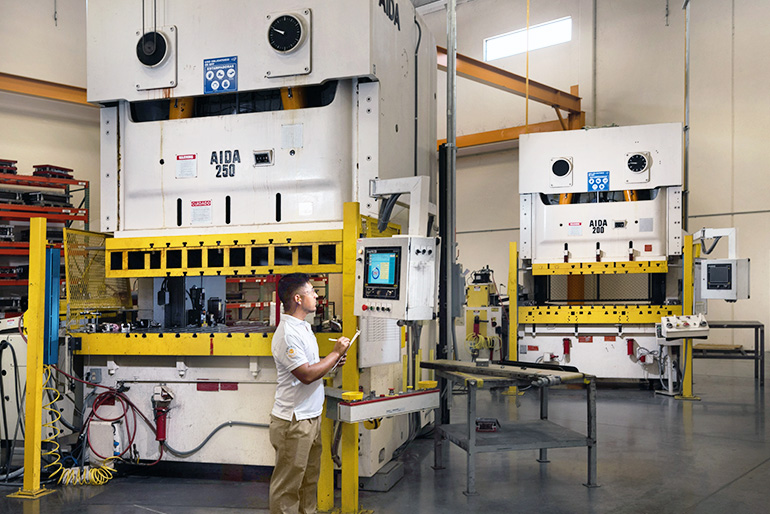Discover the Latest Developments in Metal Stamping for Precision Production
Discover the Latest Developments in Metal Stamping for Precision Production
Blog Article
The Development of Metal Stamping Procedures: Advancements and Applications
The realm of metal stamping processes has actually observed a transformative journey marked by consistent advancement and adjustment to meet the demands of modern-day industrial techniques. From the traditional techniques deeply rooted in history to the innovative technologies driving high-speed precision, the evolution of metal stamping has been absolutely nothing brief of amazing. As new tooling methods and automation find their method right into this sector, the ramifications for performance and top quality are extensive. The applications cover across a range of sectors, each benefiting uniquely from the innovations in metal stamping processes.
Conventional Steel Marking Strategies
Conventional metal marking techniques have long been the structure of producing procedures in various markets due to their performance and accuracy. The process entails creating a metal sheet or coil into a desired form by pushing it in between a die and a strike. This method is widely used for generating huge amounts of components with high accuracy at a quick pace.
Among the crucial advantages of standard steel marking methods is the capability to maintain limited tolerances, making certain that each part fulfills the required requirements constantly. This degree of precision is vital in markets such as automotive, aerospace, and electronics, where also minor deviations can cause significant concerns.
In addition, conventional steel stamping methods provide affordable solutions for mass production compared to other manufacturing methods. The ability to mark parts in fast succession lessens production time and minimizes labor costs, making it an attractive choice for services aiming to maximize their manufacturing processes.
Appearance of High-Speed Stamping

Among the crucial benefits of high-speed marking is its capacity to preserve accuracy and uniformity even at accelerated processing speeds. This accuracy is important in industries where limited resistances and intricate designs are called for. Furthermore, high-speed marking permits the handling of a large range of materials, including aluminum, stainless-steel, and copper, more expanding its applicability throughout different markets.
Moreover, the development of high-speed stamping has made it possible for visit homepage makers to meet the growing need for complex elements in markets such as automobile, aerospace, and electronic devices (Metal Stamping). By leveraging the rate and precision of high-speed marking innovation, firms can enhance their competitiveness in a rapidly progressing market landscape
Improvements in Tooling Innovation
With the advancement of high-speed marking allowing enhanced accuracy and effectiveness in steel forming processes, the area of steel stamping has seen significant innovations in tooling modern technology. Tooling modern technology plays a vital role in metal stamping procedures, affecting factors such as item top quality, manufacturing rate, and total cost-effectiveness. One key advancement in tooling innovation see here now is the development of intelligent tooling systems that incorporate sensing units and keeping track of gadgets to provide real-time data on the stamping process. These systems can discover concerns such as device wear or misalignment, enabling instant modifications to keep optimum efficiency.
Additionally, developments in materials scientific research have actually led to the production of tooling products with improved resilience, put on resistance, and thermal conductivity. By using these innovative materials, tooling makers can produce passes away and mold and mildews that endure the high stress and temperature levels involved in steel marking procedures, resulting in longer tool life and improved manufacturing performance. Furthermore, innovations in device design, such as using simulation software and additive production methods, have enabled the development of complex tooling geometries that were previously challenging to generate. Overall, these improvements in tooling technology have actually transformed the metal stamping market, enabling suppliers to achieve greater degrees of precision, performance, and cost savings.
Assimilation of Automation in Stamping
As automation remains to improve the landscape of steel stamping processes, the combination of automated systems has actually become significantly prevalent in modern production facilities. Automated systems provide various advantages in metal marking, consisting see this of increased effectiveness, enhanced accuracy, and enhanced safety. By including automation right into stamping processes, manufacturers can reduce cycle times, decrease material waste, and optimize production throughput.
Among the essential parts of automation in stamping is using robotic arms for jobs such as product handling, component adjustment, and quality evaluation (Metal Stamping). These robot systems can do recurring and labor-intensive tasks with speed and accuracy, freeing up human operators to focus on even more complex operations. Additionally, automation enables real-time surveillance and change of marking processes, causing higher total procedure control and quality control
Additionally, the assimilation of automation in stamping makes it possible for makers to achieve constant part high quality, meet limited resistances, and enhance general productivity. As innovation remains to advancement, the duty of automation in metal marking processes is expected to broaden better, driving development and effectiveness in the production industry.
Applications Across Diverse Industries
Incorporating metal marking processes throughout diverse sectors showcases the adaptability and flexibility of this manufacturing strategy. In addition, the home appliance industry benefits from metal stamping processes to make components for refrigerators, cleaning makers, and other household devices. The versatility of steel marking processes makes it a useful manufacturing method throughout different markets, demonstrating its significance in modern production procedures.
Conclusion

Report this page